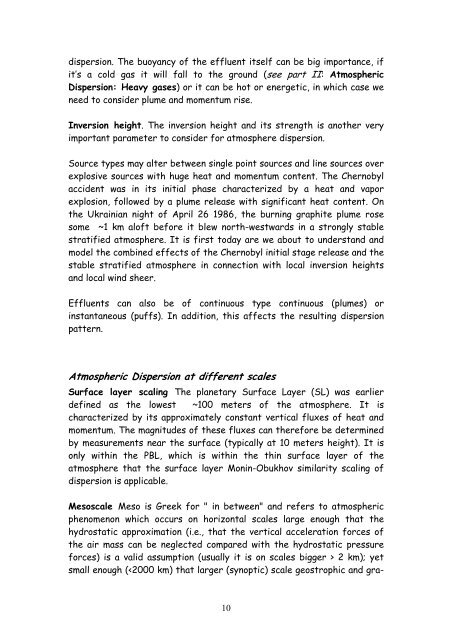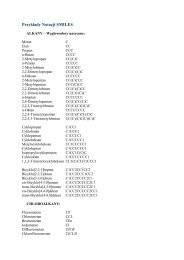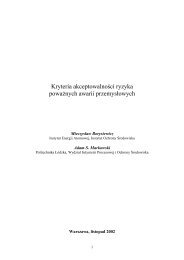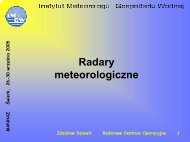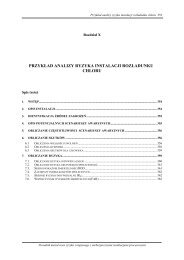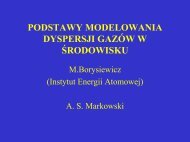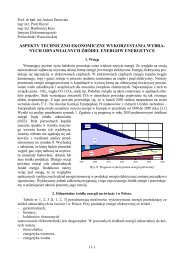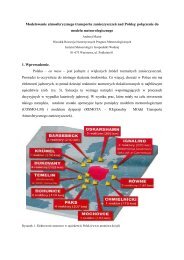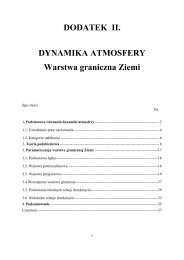Modelling of Pollutant Transport in the Atmosphere - MANHAZ
Modelling of Pollutant Transport in the Atmosphere - MANHAZ
Modelling of Pollutant Transport in the Atmosphere - MANHAZ
You also want an ePaper? Increase the reach of your titles
YUMPU automatically turns print PDFs into web optimized ePapers that Google loves.
dispersion. The buoyancy <strong>of</strong> <strong>the</strong> effluent itself can be big importance, if<br />
it’s a cold gas it will fall to <strong>the</strong> ground (see part II: Atmospheric<br />
Dispersion: Heavy gases) or it can be hot or energetic, <strong>in</strong> which case we<br />
need to consider plume and momentum rise.<br />
Inversion height. The <strong>in</strong>version height and its strength is ano<strong>the</strong>r very<br />
important parameter to consider for atmosphere dispersion.<br />
Source types may alter between s<strong>in</strong>gle po<strong>in</strong>t sources and l<strong>in</strong>e sources over<br />
explosive sources with huge heat and momentum content. The Chernobyl<br />
accident was <strong>in</strong> its <strong>in</strong>itial phase characterized by a heat and vapor<br />
explosion, followed by a plume release with significant heat content. On<br />
<strong>the</strong> Ukra<strong>in</strong>ian night <strong>of</strong> April 26 1986, <strong>the</strong> burn<strong>in</strong>g graphite plume rose<br />
some ~1 km al<strong>of</strong>t before it blew north-westwards <strong>in</strong> a strongly stable<br />
stratified atmosphere. It is first today are we about to understand and<br />
model <strong>the</strong> comb<strong>in</strong>ed effects <strong>of</strong> <strong>the</strong> Chernobyl <strong>in</strong>itial stage release and <strong>the</strong><br />
stable stratified atmosphere <strong>in</strong> connection with local <strong>in</strong>version heights<br />
and local w<strong>in</strong>d sheer.<br />
Effluents can also be <strong>of</strong> cont<strong>in</strong>uous type cont<strong>in</strong>uous (plumes) or<br />
<strong>in</strong>stantaneous (puffs). In addition, this affects <strong>the</strong> result<strong>in</strong>g dispersion<br />
pattern.<br />
Atmospheric Dispersion at different scales<br />
Surface layer scal<strong>in</strong>g The planetary Surface Layer (SL) was earlier<br />
def<strong>in</strong>ed as <strong>the</strong> lowest ~100 meters <strong>of</strong> <strong>the</strong> atmosphere. It is<br />
characterized by its approximately constant vertical fluxes <strong>of</strong> heat and<br />
momentum. The magnitudes <strong>of</strong> <strong>the</strong>se fluxes can <strong>the</strong>refore be determ<strong>in</strong>ed<br />
by measurements near <strong>the</strong> surface (typically at 10 meters height). It is<br />
only with<strong>in</strong> <strong>the</strong> PBL, which is with<strong>in</strong> <strong>the</strong> th<strong>in</strong> surface layer <strong>of</strong> <strong>the</strong><br />
atmosphere that <strong>the</strong> surface layer Mon<strong>in</strong>-Obukhov similarity scal<strong>in</strong>g <strong>of</strong><br />
dispersion is applicable.<br />
Mesoscale Meso is Greek for " <strong>in</strong> between" and refers to atmospheric<br />
phenomenon which occurs on horizontal scales large enough that <strong>the</strong><br />
hydrostatic approximation (i.e., that <strong>the</strong> vertical acceleration forces <strong>of</strong><br />
<strong>the</strong> air mass can be neglected compared with <strong>the</strong> hydrostatic pressure<br />
forces) is a valid assumption (usually it is on scales bigger > 2 km); yet<br />
small enough (


